Fire Emblem: Three Houses asks a lot of you. Every piece, from battle to friendships to training your units, must be managed both individually and as part of a whole. It can be intimidating, but when it all clicks together, it really clicks. Mastering the art of thoughtful lesson planning as a professor improves your performance on the battlefield, where success relies on calculated teamwork and deft execution. Cultivating relationships during battle in turn draws you closer to each of the characters, who you then want to invest even more time into in the classroom. Every piece feeds into the next in a rewarding, engrossing loop where you get lost in the whole experience, not just in the minutiae.
Three Houses casts you as a mercenary who, while out on a mission with their father, runs into a group of teens under attack. After a brief introduction and battle tutorial--which you shouldn't need, since you're apparently already an established mercenary, but we'll go with it--you learn that they are students at Garreg Mach monastery. Each of them leads one of the school's three houses: Black Eagles, Blue Lions, or Golden Deer. At the behest of the church's archbishop, who definitely gives off nefarious vibes but is also a gentle mom figure, you end up becoming a professor and must choose which of the houses to lead. There is a lot of mystery to the setup, with consistent hints that something is not quite right, and it's easy to get absorbed in trying to figure out what the archbishop and various other shady figures are up to.
Your main role as professor is to instruct your students in matters of combat and prepare them for story battles at the end of each month. Battles in Three Houses feature the same turn-based, tactical combat at the heart of the series, albeit with some changes. The classic weapon triangle is downplayed quite a bit in favor of Combat Arts, which have been altered somewhat from their introduction in Fire Emblem Echoes: Shadows of Valentia. Combat Arts are attacks tied to a weapon type and can boost a unit's attack power at the expense of weapon durability; some are effective against specific enemy types, like armored units. You can also unlock skills outside of Combat Arts that grant you better stats with certain weapons, like a heftier boost for using an axe against a lance user, similar to the old weapon triangle. It's the same complexity the series is known for but less abstracted, making it a bit easier to strategize without sacrificing depth.
One of the big combat additions is battalions, mini armies you can equip that provide various benefits to a unit during battle. They also give you a new type of attack called a Gambit, which varies based on the type of battalion--magic-focused, brute force, and so on--and stuns the enemies it hits. Gambits are limited-use and can be incredibly powerful against the right enemies. You can increase a Gambit's effectiveness even further if one or more of your other units are within attack range of the target, a tried-and-true Fire Emblem concept that applies to all kinds of attacks. There's also an anime-style splash screen as you attack that shows each character involved in the Gambit looking fierce, which adds a nice bit of drama.
How much you use Combat Arts and Gambits depends on what difficulty you're on. On Normal difficulty, well-trained units will likely be able to dispatch most enemies in one or two hits without the help of Combat Arts or Gambits. On Hard, however, enemies hit harder and withstand your attacks better. You have to think much more carefully about unit placement, the best time to use a Gambit and take advantage of its stun effect, and how many Combat Arts you can fire off before your weapon breaks. This is where things get exciting; after a few turns of cautious setup, you (hopefully) get to knock out tons of enemies as your plans fall into place.
Some of the early-game and optional battle maps are open spaces that don't require you to think too hard, especially on Normal. But the story battles throughout feature a variety of map layouts--from pirate ships to what appears to be a lava-filled cavern--that challenge you to consider where your units need to be, both in the next turn and several turns down the line. Many of them have different routes, enemies coming at you from multiple angles, optional treasure to chase, and other quirks that require you to split your party up or change their equipped classes to suit the situation. Thieves, for instance, can open chests and doors without a key, while flying units don't take damage from ground that's on fire.
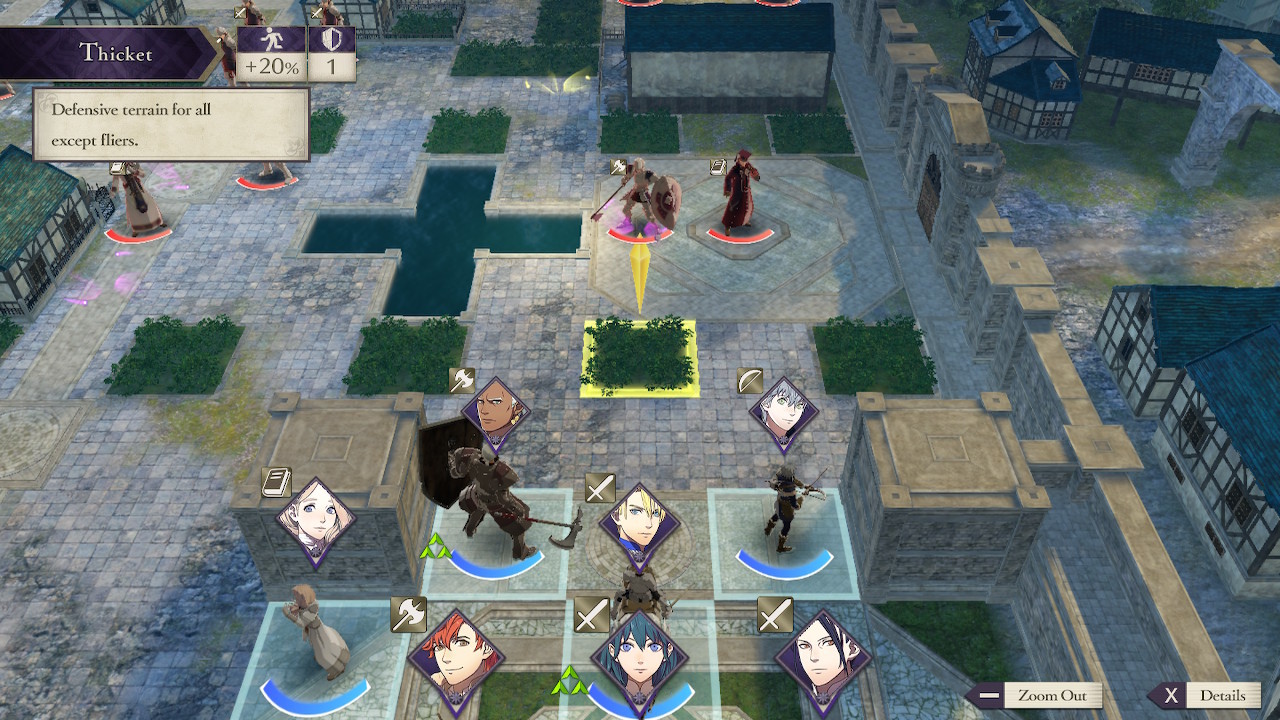
The depth of strategy in these elements really shines on Hard difficulty, but especially so when coupled with Divine Pulse, another limited-use ability. Divine Pulse allows you to rewind time in order to redo all or part of the battle, usually if one of your units dies. Rewinding with Divine Pulse shows just how important unit placement and attack choice can be, as even a slight change can make or break the encounter. It's also just a nice quality-of-life feature if you play on Classic mode, in which units who die in battle are lost forever and can't fight or train anymore. You might still soft reset from time to time, but it's great to be able to rectify a mistake right away and get a shot of instant gratification for a job well re-done.
Battling, of course, is only one part of life at the monastery. The backbone of Three Houses is the monthly school calendar, and if you like organizing things, planning ahead, or school in general, this can be the most engrossing part. On Sundays, you have free time you can spend in one of four ways: exploring the monastery, participating in side battles, holding a seminar to improve your students' skills, or simply taking the day off. Mondays are for instruction, which consists of selecting students from a list and choosing a few of their skills to boost. The rest of the week goes by automatically, with a sprite of the professor running along the calendar and stopping occasionally for random events or story cutscenes. It sounds a bit hands-off, but there's a lot to think about as it is, and the week-by-week rather than day-by-day structure keeps things moving and ensures you never have to wait too long to progress in any area.
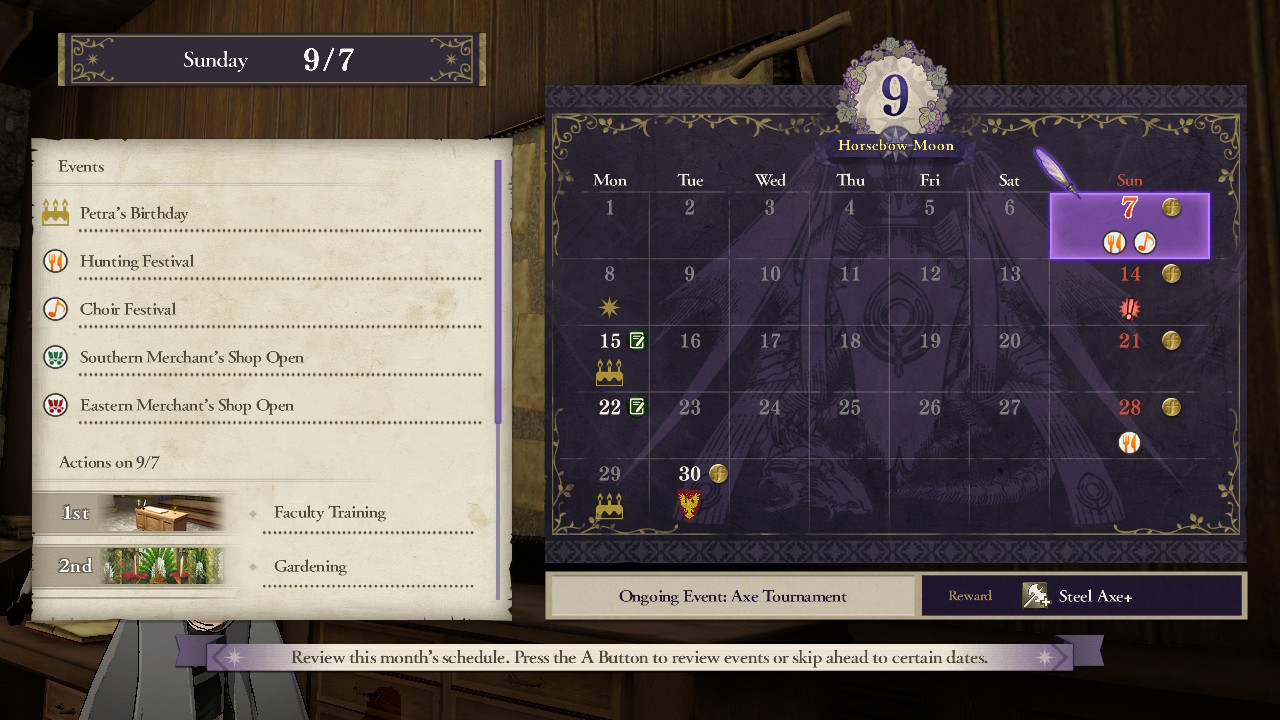
The predictable structure of each month--and the fact that you can see the full month's schedule with events listed ahead of time--gives you the foundation to make effective plans. All that time management can definitely be overwhelming, at least at first. You have to keep tabs on your students' skills and study goals, your own skills, everyone's inventory, and various other meters and menus while planning for the lessons and battles to come. But you're treated to a near-constant stream of positive reinforcement as those meters fill up week by week and your students improve their skills. You're always moving toward the next thing: the next level up, the next skill you need to develop, the next month and what may unfold.
To complement this, your activities when exploring the monastery (as well as how many battles you can participate in, if you choose to battle on your day off) are limited by activity points. You get more as your "professor level" increases, which means you have to balance activities that boost your professor level with ones that help your students grow. Activity points also ensure that the month continues at a healthy pace, preventing you from lingering on any one Sunday for too long. Seminars and rest days just eat up the whole day without consideration for activity points, which can break up the more involved weeks and provide their own benefits.
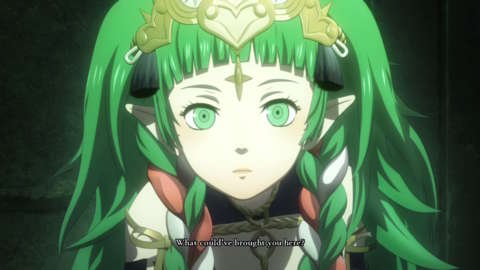
How you choose to spend your time also comes down to how motivated your students are to learn. Each of your students has a motivation gauge that's drained when you instruct them, and they can't be instructed again until you interact with them and get their motivation back up. You can do this most effectively when exploring the monastery--where you get to talk to different characters, give them gifts, and share bonding time with them--whereas battle only rarely increases motivation levels. While you can skip a lot of the school life bits and even automate instruction, you won't get the best results. You're directly at a disadvantage in combat if you don't make time for your students, which is by design.
Like all recent Fire Emblem games, keeping you invested in your units and their relationships is the glue that binds the whole experience together. It's incredibly effective in Three Houses, where your direct involvement in nearly all aspects of a unit's growth trajectory gives you a special stake in their success. After spending time and effort to help a character achieve their full potential, you're not just satisfied when they win a fight--you're proud. And the more you invest in someone--both emotionally and through months of lesson plans and instruction--the more cautious you'll be about putting them in harm's way, and the more you'll work to come up with a solid battle strategy.
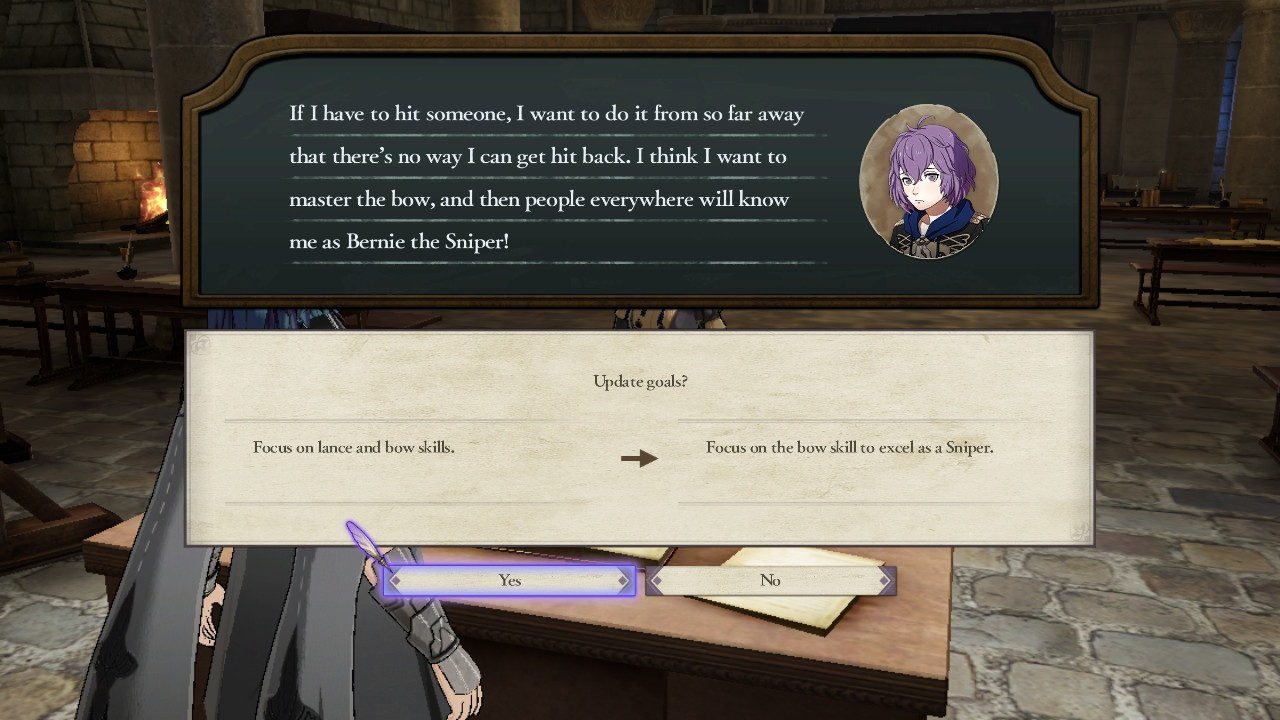
Considering you're a teacher, it's good rather than disappointing that there's almost no romance to speak of. Some students are flirty, but mainly, you're fostering camaraderie rather than playing matchmaker or romancing them yourself. As you unlock new support levels with different characters--both by interacting with them at the monastery and by using teamwork in battles--you get cutscenes that flesh them out more. Some are charming, lighthearted conversations between two friends, while many of them give you insight into more serious matters--a father forcing his daughter into marriage, discrimination within the monastery, the dark reason behind someone's lofty ambitions. For the most part, each support conversation is just a piece of who a character is, and as you slowly build support levels over time, you begin to uncover the full picture of each person. As a result, learning more about each of the characters and their place in the monastery is as much a reward for progress as the level bars that tick forever upward as you go.
Every NPC is fully voiced in both English and Japanese, which brings a lot of life to the brief support conversations. Disappointingly, though, the professor is silent. They do have a voice--they'll occasionally say a line when leveling up or improving a skill--but in cutscenes and when talking to students and faculty, they just nod or shake their head flatly. There are brief dialogue options during conversations, but where they could give way to a full, subtitled sentence or two from the professor, you're just left with the other character's reaction. Characters do, however, refer to the professor's personality and how they come across throughout the game, which is odd considering they mostly nod at things. This puts distance between you and the characters you're bonding with, and it's a missed opportunity in a game where the protagonist has an otherwise set look, personality, and backstory.
It's not hard to like a lot of the characters, though. They draw you in with anime archetypes--the ladies' man, the bratty prince, the clumsy but well-meaning girl--and surprise you with much more nuance under the surface. Some of the funniest scenes early on involve Bernadetta, a shut-in with extreme reactions to normal social situations, but her inner life is a lot darker and more complicated than those early conversations let on. You might discover a character you thought was a jerk is actually one of your favorites or slowly stop using a less-than-favorite character in battle. You also have the option of having tea with someone, during which you have to choose conversation topics according to what you know about them, dating sim-style. Knowing what topics they'll like is actually a lot harder than it sounds, and successfully talking to a favorite character--even if the tea setup can be a little awkward in practice--is a small victory.
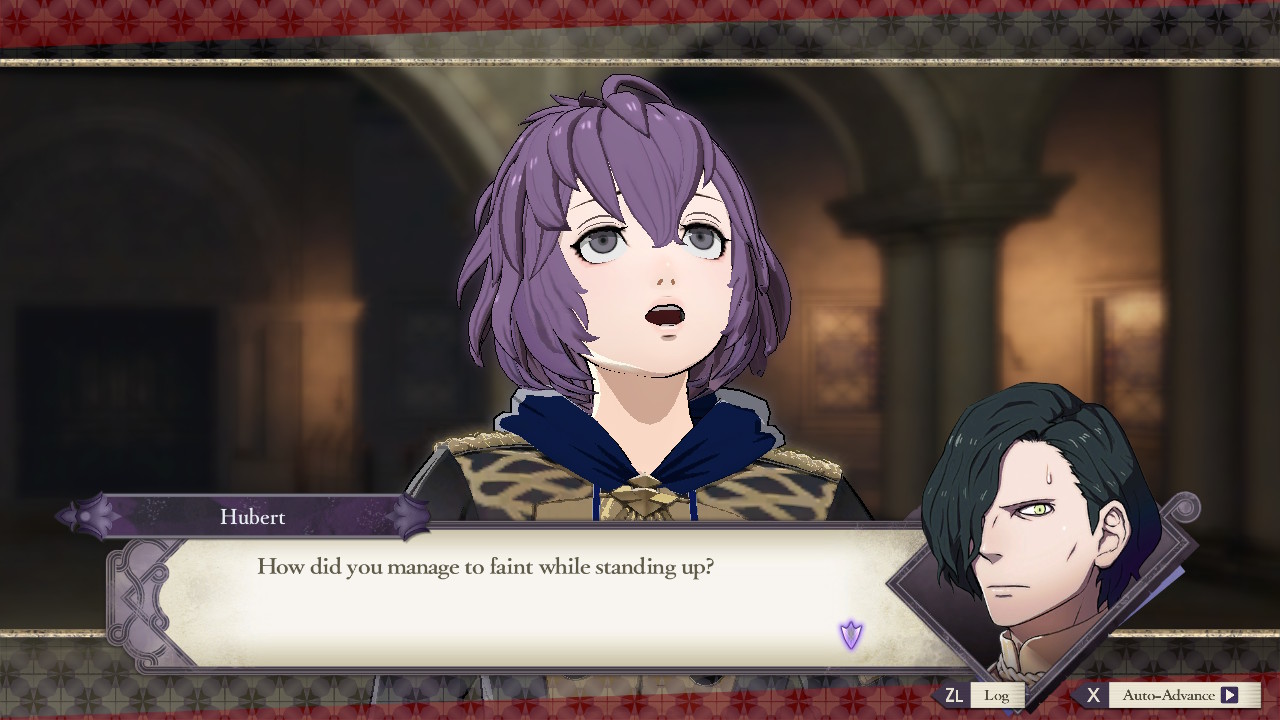
Each house's campaign feels distinct but not so different that one seems way better than the other. Every house has a mix of personalities and skills, and they all have their own advantages and disadvantages. Students from different houses can form friendships with each other, too, and you can eventually recruit students from other houses to join yours. Rather than being repetitive, on a second playthrough, recruiting gives you access to different relationship combinations; you can see a different side to a character through a different set of support conversations. And while the overall setup of the game is largely the same across the three houses, each has its own web of B plots, and the second half of the game will look very different depending on who you're with and the choices you've made.
The first half concerns the church, its secrets, and the fact that the professor knows very little about their own identity. As the basic loop of each month pulls you forward, so too does the promise of learning the truth about something, whether it's why the archbishop wanted you to be a teacher in the first place or who a suspicious masked individual is. These threads remain pretty open, though, at least after one and a quarter playthroughs. You get different details in each route, and so far it's been a long process to piece everything together.
Learning more about each of the characters and their place in the monastery is as much a reward for progress as the level bars that tick forever upward as you go.
After a five-year time skip, you enter the "war phase" of the game. While the structure of the game is the same--you even instruct your units, since you still need to train for battle--the focus shifts to the house-specific stories. They involve a lot of hard decisions, with old friends becoming enemies, people you wish you didn't have to kill, and students who've changed either in spite or because of your guidance. Late-game battles are especially challenging, with higher stakes and multi-lane layouts that require a lot of forethought. Success in these battles is incredibly rewarding, as you're seeing dozens of hours of investment in your students reach a crescendo, but they're bittersweet in context.
When all was said and done, all I could think about was starting another playthrough. I was curious about the mysteries left unsolved, of course, but I also hoped to undo my mistakes. There were characters I didn't talk to enough, students I didn't recruit, and far more effective ways to train my units. A second playthrough treads familiar ground in the beginning, but after learning and growing so much in the first, it feels fresh, too. That speaks to Three Houses' mechanical complexity and depth as well as the connections it fosters with its characters--and whether you're managing inventories or battlefields, it's the kind of game that's hard to put down, even when it's over.



















